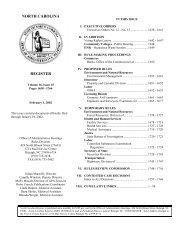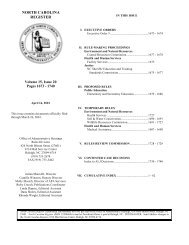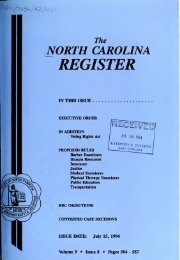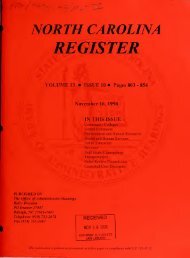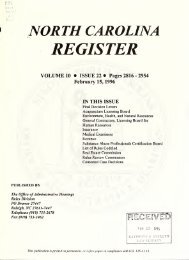NC Register Volume 21 Issue 09 - Office of Administrative Hearings
NC Register Volume 21 Issue 09 - Office of Administrative Hearings
NC Register Volume 21 Issue 09 - Office of Administrative Hearings
You also want an ePaper? Increase the reach of your titles
YUMPU automatically turns print PDFs into web optimized ePapers that Google loves.
CONTESTED CASE DECISIONS<br />
6. Respondent issued a final NPDES Phase II stormwater permit to Mecklenburg County, including the Town <strong>of</strong> Mint<br />
Hill, on June 15, 2005, with effective dates from July 1, 2005, through June 30, 2010.<br />
7. Respondent issued a final NPDES Phase II stormwater permit to the Town <strong>of</strong> Indian Trail on September 1, 2005,<br />
with effective dates from October 1, 2005, through September 30, 2010.<br />
8. Respondent issued a final NPDES Phase II stormwater permit to the Town <strong>of</strong> Stallings on September 7, 2005, with<br />
effective dates from October 1, 2005, through September 30, 2010.<br />
9. Goose Creek is a perennial stream fed by a number <strong>of</strong> perennial, intermittent and ephemeral tributaries. Goose Creek<br />
is a tributary to the Rocky River, which is in turn a tributary to the Pee Dee River (the lower portion <strong>of</strong> the Yadkin River). The Goose<br />
Creek watershed is located in southeastern Mecklenburg County and northwestern Union County, North Carolina. Portions <strong>of</strong> the<br />
Towns <strong>of</strong> Indian Trail, Stallings, and Mint Hill drain into the Goose Creek watershed.<br />
10. The Carolina heelsplitter is a species <strong>of</strong> freshwater mussel. The U.S. Fish & Wildlife Service (“USFWS”) listed the<br />
Carolina heelsplitter as endangered pursuant to the provisions <strong>of</strong> the Endangered Species Act on June 30, 1993. 58 Fed. Reg. 34,926<br />
(June 30, 1993).<br />
11. The Goose Creek watershed contains one <strong>of</strong> only seven remaining populations <strong>of</strong> the Carolina heelsplitter. In July<br />
2002, the USFWS designated critical habitat for the Carolina heelsplitter, including portions <strong>of</strong> the main stems <strong>of</strong> Goose Creek and<br />
Duck Creek in Union County. 67 Fed. Reg. 44,502-44,5<strong>21</strong> (July 2, 2002) Since the USFWS listed the Carolina heelsplitter as<br />
endangered, it has discovered two additional populations, raising the total to nine.<br />
12. Goose Creek has its headwaters in southeastern Mecklenburg County within the jurisdiction <strong>of</strong> the Town <strong>of</strong> Mint<br />
Hill. Stormwater run<strong>of</strong>f from Mint Hill flows into Goose Creek at its headwaters and travels downstream into the critical habitat for<br />
the Carolina heelsplitter. Stormwater run<strong>of</strong>f from Indian Trail and Stallings flows into Goose Creek and travels downstream into the<br />
critical habitat for the Carolina heelsplitter.<br />
13. The North Carolina Wildlife Resources Commission (“WRC”) and the USFWS have jointly submitted to<br />
Respondent a draft technical support document containing their recommendations for a site-specific management plan to protect and<br />
preserve habitat for threatened or endangered species in Goose Creek.<br />
14. The WRC, in coordination with the USFWS, also has issued guidance regarding water quality conditions required to<br />
sustain and recover federally listed endangered species, including the Carolina heelsplitter.<br />
15.The NPDES Phase II stormwater permits Respondent issued to the Towns <strong>of</strong> Indian Trail and Stallings and Mecklenburg<br />
County, set the imperviousness threshold at twenty-four percent and require thirty-foot buffers on perennial and intermittent streams in<br />
the Goose Creek watershed.<br />
16. Under the NPDES Phase II stormwater permits Respondent issued to the Towns <strong>of</strong> Indian Trail and Stallings and<br />
Mecklenburg County, developments with a built upon area less than twenty-four percent are not required to implement engineered<br />
stormwater management controls to treat stormwater pollution.<br />
17. Goose Creek does not meet water quality standards for fecal coliform. In 1998, Respondent placed Goose Creek on<br />
the 303(d) list <strong>of</strong> impaired waters due to fecal coliform violations. According to Respondent’s listing document, the causes <strong>of</strong> water<br />
quality impairment in Goose Creek include construction activities and urban run<strong>of</strong>f/storm sewers. Goose Creek remains on the 303(d)<br />
list <strong>of</strong> impaired waters through the present.<br />
18. On April 20, 2005, Respondent finalized and submitted to the U.S. EPA Total Maximum Daily Loads (“TMDL”)<br />
for Fecal Coliform for Goose Creek. The TMDL allocates allowable pollutant loads from known sources so that required actions may<br />
be taken to restore the water to its intended uses.<br />
19. The U.S. EPA approved and finalized the Goose Creek TMDL without substantial change on July 8, 2005.<br />
20. The waste load allocation in the Goose Creek TMDL requires a ninety-two point five percent reduction <strong>of</strong> fecal<br />
coliform discharges from existing MS4s. EPA approved and finalized the Goose Creek TMDL without substantial change on July 8,<br />
2005.<br />
<strong>21</strong>:<strong>09</strong> NORTH CAROLINA REGISTER NOVEMBER 1, 2006<br />
867




